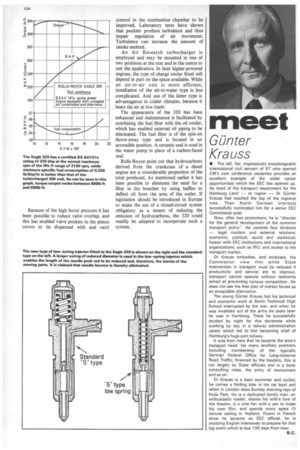The first Eagle in
Page 103

Page 104

If you've noticed an error in this article please click here to report it so we can fix it.
new R-B, range
by Paul Brackington A FOUR-VALVE cylinder head designed for high-boost turbocharging is an outstanding feature of the Rolls-Royce Eagle 320 which has a gross rating of 320 bhp, certified to the BS AU141a standard, it is designed for further increases in power output and is the first of a new Eagle series of high-output diesels. It is exhibited on the company's stand at Earls Court (Stand 325) alongside a display model of a 340 bhp turbocharged/charge-cooled engine of a type that will be available in due course. Examples of the standard Eagle Mk II range are also on view.
Other notable features of the 320 include a "low-spring" injector having a needle push rod of reduced length, which gives a corresponding reduction in inertia and is said to eliminate needle bounce, to increase the wear life of the injector and to be favourable to improved smoke control and fuel consumption. An injection pump with cams of modified form gives a matched injection rate at acceptable stress levels, while crankcase baffles obviate the need for a filter in the breather system.
The injectors are mounted on the side of the block and any fuel that might leak from them would not contaminate the lubricating oil. This would be the case if they were mounted in the rocker box; and side mounting provides easier servicing. The angled holes of the four-hole nozzle provide a symmetrical spray pattern, relative to the centrally located torroidal combustion chamber, with a 140deg cone angle compared with the normal 150deg angle. It is claimed that the spray pattern provides optimum droplet penetration which gives better fuel consumption and reduces smoke. The squish area of the piston is matched to the spray pattern to produce good swirl characteristics in the combustion chamber without "over swirl".
Rolls-Royce emphasise that a two-valve head is the more suitable type for naturally aspirated diesels and for units turbocharged at a relatively low pressure. A four-valve head had the advantage at higher outputs because it gives better control of pre-combustion swirl at increased air-flow rates, the control provided by two valves being the more efficient at lower rates. Rolls-Royce Mk II 205 and 220. naturally aspirated diesels and the turbocharged units in this range, the 280 and the 305, will, therefore, continue in production fitted with a two-valve head. In common with the standard models, the 320 has two heads; and it is only 231b heavier than the Eagle 305.
The cylinder head port passages are cast to the required shape, and while this necessitates air-flow testing of each engine on the production line and correction of any faults by fettling, it enables the two sections of a port passage to be "blended" at an intersection to reduce flow losses, which would be impossible with machined ports. And this promotes uniform flow through all the ports.
The two inlet ports are located one above the other and the lower port, which is the shorter of the two, is the main contributor to swirl promotion, a swirl crescent being machined in the head adjacent to the valve seat. The rockers are mounted in two aluminium rocker boxes, bolted to the heads, which gives increased rigidity compared with the normal type of mounting and aids accurate valve-control.
Minimum specific fuel consumption of the 320 is obtained at 1550 rpm, and at 0.3381b/bhp /hr shows an improvement of about 0.010tb /bhp /hr compared with the Eagle 305 turbocharged diesel Maximum power output of the 320 is produced at 2100 rpm, which corresponds with the peak rpm of standard Mk IT units, while its maximum torque of 9001b ft is obtained at 1300 rpm. The compression ratio is 14 to 1. Because of the high boost pressure it has been possible to reduce valve overlap, and this has enabled valve pockets in the piston crown to be dispensed with and swirl control in the combustion chamber to be improved. Laboratory tests have shown that pockets produce turbulence and thus impair regulation of air movement. Turbulence can increase the amount of smoke emitted.
An Air Research turbocharger is employed and may be mounted in one of two positions at the rear and in the centre to suit the application. In later higher-powered engines, the type of charge cooler fitted will depend in part on the space available. While an air-to-air unit is more efficient, installation of the air-to-water type is less complicated. And use of the latter type is advantageous in colder climates, because it heats the air at low loads.
The appearance of the 320 has been enhanced and maintenance is facilitated by combining the fuel filter with the oil cooler, which has enabled external oil piping to be eliminated. The fuel filter is of the spin-on throw-away type and is located in an accessible position. A ceramic seal is used in the water pump in place of a carbon-faced seal: Rolls-Royce point out that hydrocarbons derived from the crankcase of a diesel engine are a considerable proportion of' the total produced. As mentioned earlier it has been possible to eliminate the need for a filter in the breather, by using baffles to deflect oil from the area of the outlet. If legislation should be introduced in Europe to make the use of a closed-circuit system obligatory as a means of reducing the emission of hydrocarbons, the 320 could readily be adapted to incorporate such a system.
































































































































































































































































































































































































































































































































